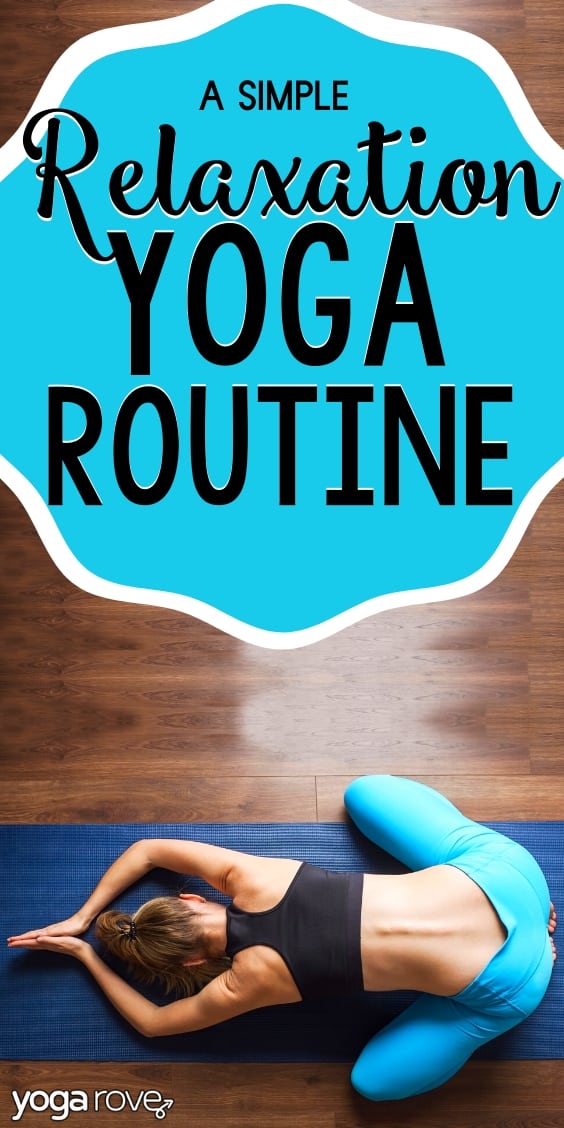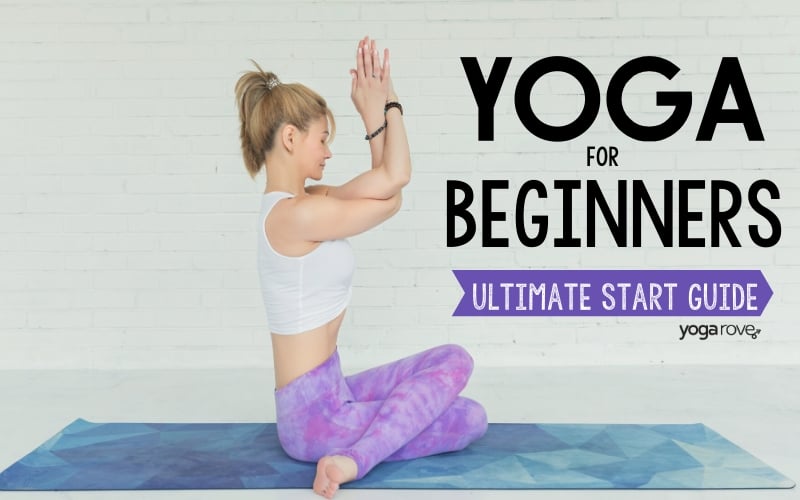This post may contain affiliate links. Please read our disclosure for more info.
Whether you’re having trouble falling asleep at night, feeling stiff, suffering from anxiety, or even lower back pain, yoga can help you. Integrating a simple yoga routine into your day or before bed can help you feel more flexible, ease back pain and relax your body and mind before going to bed.

Which type of yoga is best for relaxation?
The best type of yoga for relaxation usually incorporates slow, untaxing postures that have a strong focus on the mind-body connection. The poses are gentle and aim to softly relieve tension, while promoting a deep sense of calm.
Yin Yoga is a style of yoga that incorporates long holds (up to 10 minutes). It helps improve your flexibility, release tension and trains your mind to stay focused on the present moment.
Restorative Yoga, referred to as Gentle Yoga sometimes, is also great for relaxation. It involves passive stretches, and is mostly practiced lying down.
How does yoga relax the mind?
Yoga is a combination of mental and physical exercises that help you relax. Yoga works with pranayama, or breath control, which helps you become aware of your breath and have control over it.
You can use this to your advantage in other situations: when you’re very stressed or scared, your breaths tend to be shallow and short, which only leads to more anxiety. If you learn to control your breath, you can make a conscious effort to lengthen your breaths, which has a calming effect.
Meditation is also an integral part of yoga and can help you become more present and less stressed. If you attend yoga classes, you might hear the teacher say: “You’re here now.” It sounds very obvious, but what he/she means is: don’t let your mind wander, don’t think about the rest of your day or what you should have for dinner. Accept the present moment as it is and stay centered.
That also means that there is nothing you need to worry about, because nothing else other than doing yoga matters right now. With this attitude it becomes a lot easier to devote time to yourself and relax.
Is it good to do yoga before bed?
Yes! Yoga is a great way to relax before bed and to improve your quality of your sleep. Instead of spending time on social media before going to bed (a study has found that night-time phone use has a negative effect on your sleep quality), try doing some yoga.
It increases your blood flow, relaxes your muscles and helps you de-stress. I don’t recommend very intense yoga before going to bed because it will increase your heart rate and you’ll end up feeling very energized – try something gentler instead (like the routine below!), maybe use props like blocks and straps and dim the light or light a candle.
A Relaxing Yoga Routine for Beginners
I’ve decided to create a relaxing yoga routine for beginners that you can do at any time of the day when you need to de-stress and stretch out. Hold every pose for approximately one minute. (Hold the poses that are performed on the left and right side one minute each side).
1. Easy Seat
- Start in a comfortable cross-legged seated position with your spine straight.
- You can place a cushion under your butt if you’re not comfortable. Place your hands on your knees and close your eyes.
- Let go of the day you’ve had or the day ahead and focus on where you are now. How is your body feeling? How are you breathing? Take a few conscious, deep inhales and long exhales.
2. Neck rolls
- Release the tension in your neck by leaning your left ear towards your left shoulder, then roll over to your right shoulder.
- Come back to the left and repeat the motion five times. If it doesn’t hurt your neck, you can also draw full circles from the back to the front.
3. Seated Cat-Cow Pose
- Staying seated, hold on to your knees, and inhale to open your chest.
- Press the shoulders back and the chest forward, look up.
- Exhale round your spine, your head bows.
- Repeat this stretch five times to release tension in your back and improve shoulder flexibility.
4. Seated Side Stretch
- Interlace your fingers and stretch them up over your head as if you just woke up, look up to release your neck.
- On the next exhale, bring your right hand down to your right side, lift your left arm up and over to the right.
- Your left arm should be in line with your left ear, you don’t want to round your back – your chest should stay open.
- If you feel comfortable here, you can even set your right forearm down to deepen the stretch in your left side. This pose opens your side body. Repeat on the other side.
5. Seated Cross-Legged Forward Bend
- Come back to the center, inhale sit up tall, exhale slowly walk your hands forward and bend over your crossed legs.
- Keep the sitting bones grounded – it doesn’t matter how far forward you bend.
- You can also place a block or a blanket under your arms if you don’t comfortably reach the floor.
- Release the neck and lead the head hang, then change the crossing of your legs and repeat on the other side. This pose stretches your hips and lengthens your spine.
6. Half Cow Face Pose
A strange name, I know, but this pose is a great shoulder stretch and chest opener.
- On an inhale, lift your right arm up, exhale bend your arm. Your right elbow is pointing up towards the sky, your right hand is point down your back.
- On the next exhale, bend your left arm so that the elbow is pointing down and the hand up your back.
- Maybe your hands will touch- if not, hold on to a strap with both hands or hold your shirt. Repeat on the other side.
7. Wind Relieving Pose
- Lie down on your back, your legs straight.
- Exhale and draw your right knee towards your chest, hold your right shin with both hands.
- Release and hold your hamstrings or calves (depending on your level of flexibility), gently pull your right leg closer to your chest, take five breaths.
- The left leg should still be on the floor.
8. Lying Spinal Twist
- Bring your legs back down and your arms out to a T-position with your palms facing down.
- Bend your right knee to a 90° angle and draw it over to your left side on an exhale.
- Look over to the right side and knee both shoulders on the ground to stretch the back muscles and release tension.
- Repeat the exercise with your left leg.
9. Reclined Butterfly
- Come back to lying flat on your back with your legs stretched out in front of you.
- Bring your feet together so the soles are touching, knees bent and pointing towards opposite sides of the room.
- Place your hands by your sides or rest them on your stomach to feel your breaths rise and fall.
- For more comfort, you can place a blanket underneath your lower back if you feel you need more support.
10. Savasana
- Gently bring your knees back together and then lie all the way down, your palms facing up and your feet pointing outward.
- Start scanning your body from head to toe.
- Do you hold any more tension in your neck, arms, legs, feet, jaw, back? If so, make a conscious effort to relax those parts of your body. Lie in Savasana for five minutes.
Try this yoga routine whenever before going to sleep, in the morning, or whenever you feel you need to unwind and reset.
Related Questions
How do I train my mind to relax?
Yoga is not only physical, there is also a mental aspect to it that can help you relax. Don’t think about what you’ll do after yoga, or judge what has happened before. Stay present and observe the sensation you feel in your body, and whenever your mind begins to wander, bring it back to the now. This is called mindfulness. Meditation is also a great tool to help you relax.
Is it best to do yoga on an empty stomach?
Practicing yoga on an empty stomach makes it easier to focus on your practice. If you’ve eaten before yoga, you might experience nausea or bloating, or feel very heavy. Keep in mind that yoga involves the compression and twisting of the stomach – this can be quite unpleasant if you just ate a full breakfast. You can have tea, water or fruit – if you’ve had a heavy meal, wait for 3-4 hours before practicing.
What is the best time to practice yoga?
What time you practice yoga depends on your goals. If you want to wake your body up, Yoga in the morning is a great idea. You’ll also have the energy for a more active practice, something you might not have in the afternoon. If you want to relax before going to bed and let go of the stress, practicing in the evening Is best.
After completing her teacher training in India, Franziska started writing about and teaching yoga while traveling. Having her mat with her always makes her feel more at home, no matter where she is. Yoga has improved her life in many ways, and she’d like to share the numerous benefits of yoga with others.





